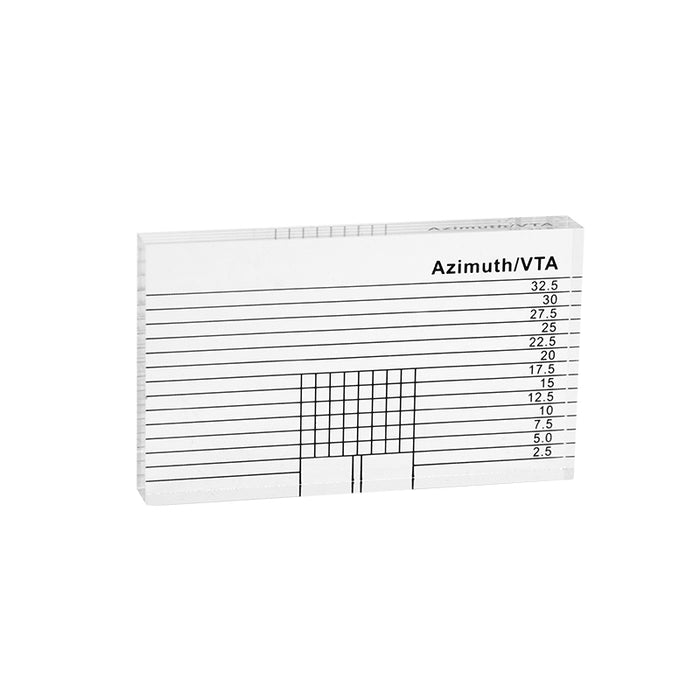
Azimuth / VTA Ruler for tonearm and cartridge adjustments
Transparent acrylic azimuth / VTA ruler used to adjust your turntable cartridge.
What is Azimuth?
Azimuth refers to the horizontal balance of the cartridge when viewed from the front. This, in turn, determines at which angle the stylus sits on the record groove.
The theoretical assumption is that when the Cartridge is perfectly perpendicular to the record groove, the stylus will sit perfectly in the record grooves.
All cartridges are made by hand and therefore, the stylus may not actually be perfectly perpendicular to the cantilever, the coil assembly at the of the cantilever or the cartridge body. This means visual methods, can only provide you with an approximation. As soon as the record spins, whether your stylus is sitting at the optimal spot is unknown, so it is impossible to achieve an accurate setup by eyesight.
If azimuth is set incorrectly, the Stylus will not sit perfectly in the record groove, signals recorded on the Left Channel will leak to the Right Channel, (or vice versa), this is leakage between Channels is called Crosstalk, and it is expressed as a negative decibel number. The higher the negative number, the lower the crosstalk, the better the channel separation.
Incorrect azimuth will also lead to degradation in other measurements such as %THD between L and R channel, as well as IMD% (Intermodulation Distortions).
What exactly is Vertical Tracking Alignment (VTA)?
To understand how Vertical Tracking Alignment works it is important to first look at the basics; the way plates are produced. In order to press a record, a press mould must always be made first, this press mould is made from a so-called master. The master is actually the same as the LP we eventually get our hands on, but with one big difference: it is not pressed, but cut.
The cutting of the grooves in the master is always done at an angle of 20 degrees, which means that the sound signal should be read by the needle of our record player at this angle for a perfect reproduction. In order to achieve this, some turntables have a VTA adjustment facility.
How to set the right VTA?
Adjusting the VTA is mainly a matter of very good listening. A good starting point for finding the right VTA is adjusting the tone arm horizontally, because almost all record players sold today are designed so that the needle will hit the record more or less the right way when the tone arm is horizontal. To check the horizontal orientation of the tone arm, you can use our VTA ruler, to check this.
From here, the listening and finding the "sweet-spot" begins. To find it, there are special test records on the market, but you can also use a record from your own record collection. It is advisable to look for a record with a well-defined bass. If the needle is tilted too far forward the bass won't be deep and full, if it's too far back it's too heavy and lacks definition.
We have to admit that it's not easy to find the right VTA, but if you want to get the most out of your turntable it's definitely worth doing.
The perfect VTA does not exist
Perhaps the above statement sounds a little strange after all the explanations we've just given, but it is unfortunately true that the perfect Vertical Tracking Alignment is not possible. Why is that? The records we listen to vary in thickness, for example a 180 gram LP is a lot thicker than a 140 gram LP. This means that the VTA will be different when playing these records on the same turntable. For this reason, it is recommended that you use a record of average thickness, or a thickness representative of your record collection, to adjust the VTA.




